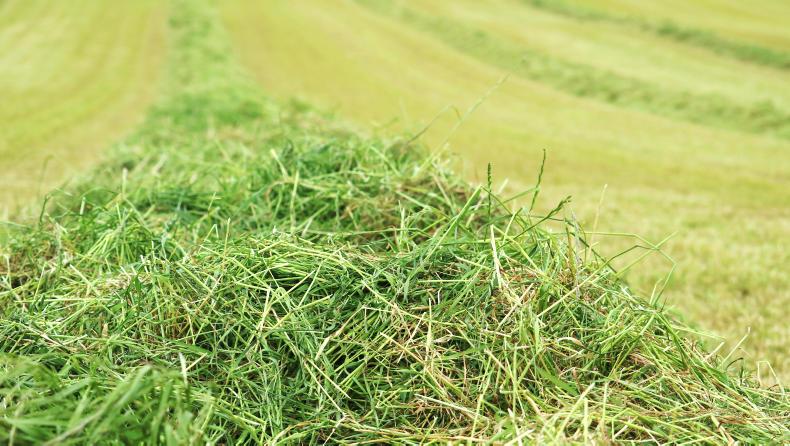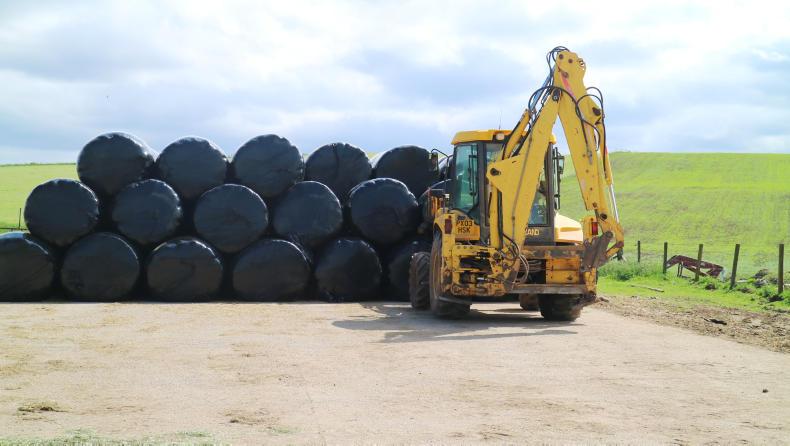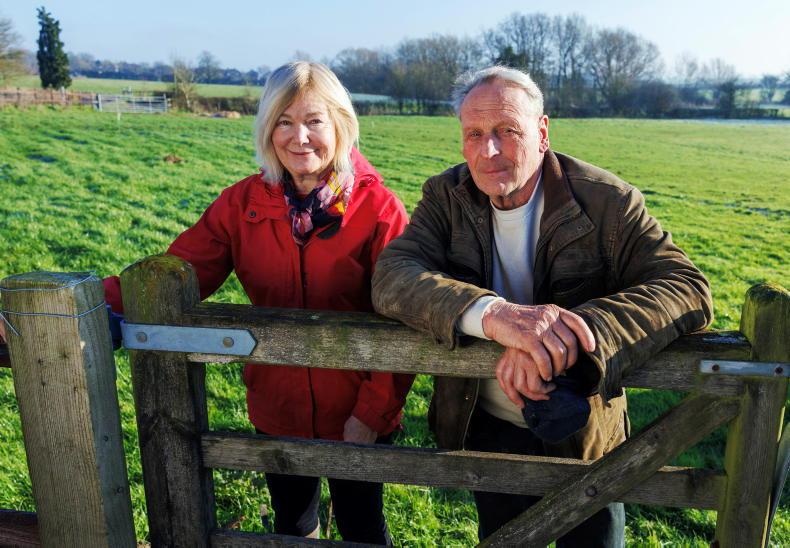The extended spell of fine weather has allowed some of the focus farms to get silage made with relative ease. Crops have been somewhat variable in places, but all in all on par with previous years.
Silage ground that was taken up early with the hope of a late May, early June cut has yielded quite well as it had enough moisture at the right time to ensure a good crop. Andrew Gammie at Drumforber Laurencekirk cut silage on the 27 of May and baled 24 hours later. Andrew was also able to take out 16ac of excess grazing at the same time as it had gone too strong for grazing. This was a great boost to winter feed stocks and the grazing yielded just as well as the silage ground at 10 bales to the acre.
 The Biffens at Arnage, Ellon made their first-cut silage on Thursday and Friday of last week, 7 and 8 June. They took in just over 50ac and yielded over 7t/acre fresh weight in near-perfect conditions. It is estimated that the dry matter will be close to 30% in this silage, giving them a dry matter yield of just shy of 5.5tDM/ha.
The Biffens at Arnage, Ellon made their first-cut silage on Thursday and Friday of last week, 7 and 8 June. They took in just over 50ac and yielded over 7t/acre fresh weight in near-perfect conditions. It is estimated that the dry matter will be close to 30% in this silage, giving them a dry matter yield of just shy of 5.5tDM/ha.
The Duffus family, Mains of Auchriachan, Tomintoul also made first-cut silage last week, 7 and 8 June. This 30ac is earmarked for young growing stock and is cut a few weeks ahead of pit silage for cows. Again, conditions were near perfect and after a 24 hour wilt the grass was baled. It yielded over six bales to the acre of what will be highly digestible feed. Dry matter of the silage will be close to 35% giving a DM yield of 3.8tDM/ha.
The Duguids at Mains of Cranna, Aberchirder are planning to cut towards the end of the week and over the weekend of the 16-17 June, weather depending. The Mackays at Greenvale, Dunnet, Thurso will be into July before they make their silage as most of the silage ground is in a Wader mown grassland scheme.
Walking the silage fields with Charles Webster, Ardhuncart Farm, Kildrummy this week it was decided that first-cut silage would be brought forward a week. It was planned for the week after the Highland Show, however given the dry conditions and the fact that the crop has gone to head, it was decided to cut the crop this weekend and go again for a second cut to meet winter requirements.
Grass gone to head
A lot of crops across the country have now gone to seed head, perhaps earlier than other years due to the prolonged dry spell. Where crops have shot there is little point waiting for it to “bulk up” for another fortnight. All that happens in this case is an increase in stem reducing the overall feed value of the silage. Another reason not to let it grow on is it also increases the length of time it takes the grass plant to recover post-harvest as it has matured so much the growing point of the plant is cut off, delaying regrowth.
The best option here is to take what crop is there now and fertilise again for a second cut to make up the shortfall. While perhaps a large second cut was not planned, it is better to take a hit now with a few extra tonnes of fertiliser and another silage contractor bill compared to leaving yourself short of silage and having to go out and buy it next spring – not knowing the availability or quality of what will be on offer.
Fertiliser
The growing silage crop will use about two units of nitrogen per day during decent grass growing conditions. Where this might not be the case this year is on ground that was fertilised late, since the start of the dry spell, meaning some nitrogen has remained on the surface. If the crop then receives rain this can wash in the nitrogen and, as grass growth increases once again, can lead to a high uptake of nitrogen by the plant.
Where there is any doubt on nitrogen levels in the crop, a fresh grass test may be well worth doing to put minds at ease. There are two things you are looking for from a fresh grass sample:
Sugar levels – Ideally you want a water soluble carbohydrate (WSC) level of over 3%. This WSC acts as the energy source for lactic acid-producing bacteria. High levels allow rapid production of lactic acid which helps drive down the pH of the ensiled crop promoting rapid fermentation. Grass nitrate levels – High grass nitrate levels increase the buffering capacity of the crop. This means it is more difficult to achieve the rapid pH drop required for optimal fermentation. High nitrate in the ensiled grass leads to the production of ammonia. This then reacts with water to form ammonium hydroxide, which is alkaline, keeping the pH of the pit high. Ideally you want nitrogen levels below 0.1%. Where it is slightly higher (0.15% - 0.25%) this can be overcome with high levels of WSC and a successful 24 hour wilt, ie good harvesting conditions. Second-cut silage
The plan on a lot of the focus farms is to take up as much ground as possible again for a second cut to boost reserves for the winter. Most of the farms used up all their reserves this spring and so are keen to make as much silage as possible this year.
The Biffens will take up the entire 50ac once again. This will be the final harvest of an Italian ryegrass mix that will go to wheat next year. They are also hoping to be able to take out some excess grazing from the sheep at some point over the next month to six weeks.
The Duffus family will take up this 30ac again for a second cut for young stock once again. Therefore this will see them harvesting again in six weeks time.
The extended spell of fine weather has allowed some of the focus farms to get silage made with relative ease. Crops have been somewhat variable in places, but all in all on par with previous years.
Silage ground that was taken up early with the hope of a late May, early June cut has yielded quite well as it had enough moisture at the right time to ensure a good crop. Andrew Gammie at Drumforber Laurencekirk cut silage on the 27 of May and baled 24 hours later. Andrew was also able to take out 16ac of excess grazing at the same time as it had gone too strong for grazing. This was a great boost to winter feed stocks and the grazing yielded just as well as the silage ground at 10 bales to the acre.
 The Biffens at Arnage, Ellon made their first-cut silage on Thursday and Friday of last week, 7 and 8 June. They took in just over 50ac and yielded over 7t/acre fresh weight in near-perfect conditions. It is estimated that the dry matter will be close to 30% in this silage, giving them a dry matter yield of just shy of 5.5tDM/ha.
The Biffens at Arnage, Ellon made their first-cut silage on Thursday and Friday of last week, 7 and 8 June. They took in just over 50ac and yielded over 7t/acre fresh weight in near-perfect conditions. It is estimated that the dry matter will be close to 30% in this silage, giving them a dry matter yield of just shy of 5.5tDM/ha.
The Duffus family, Mains of Auchriachan, Tomintoul also made first-cut silage last week, 7 and 8 June. This 30ac is earmarked for young growing stock and is cut a few weeks ahead of pit silage for cows. Again, conditions were near perfect and after a 24 hour wilt the grass was baled. It yielded over six bales to the acre of what will be highly digestible feed. Dry matter of the silage will be close to 35% giving a DM yield of 3.8tDM/ha.
The Duguids at Mains of Cranna, Aberchirder are planning to cut towards the end of the week and over the weekend of the 16-17 June, weather depending. The Mackays at Greenvale, Dunnet, Thurso will be into July before they make their silage as most of the silage ground is in a Wader mown grassland scheme.
Walking the silage fields with Charles Webster, Ardhuncart Farm, Kildrummy this week it was decided that first-cut silage would be brought forward a week. It was planned for the week after the Highland Show, however given the dry conditions and the fact that the crop has gone to head, it was decided to cut the crop this weekend and go again for a second cut to meet winter requirements.
Grass gone to head
A lot of crops across the country have now gone to seed head, perhaps earlier than other years due to the prolonged dry spell. Where crops have shot there is little point waiting for it to “bulk up” for another fortnight. All that happens in this case is an increase in stem reducing the overall feed value of the silage. Another reason not to let it grow on is it also increases the length of time it takes the grass plant to recover post-harvest as it has matured so much the growing point of the plant is cut off, delaying regrowth.
The best option here is to take what crop is there now and fertilise again for a second cut to make up the shortfall. While perhaps a large second cut was not planned, it is better to take a hit now with a few extra tonnes of fertiliser and another silage contractor bill compared to leaving yourself short of silage and having to go out and buy it next spring – not knowing the availability or quality of what will be on offer.
Fertiliser
The growing silage crop will use about two units of nitrogen per day during decent grass growing conditions. Where this might not be the case this year is on ground that was fertilised late, since the start of the dry spell, meaning some nitrogen has remained on the surface. If the crop then receives rain this can wash in the nitrogen and, as grass growth increases once again, can lead to a high uptake of nitrogen by the plant.
Where there is any doubt on nitrogen levels in the crop, a fresh grass test may be well worth doing to put minds at ease. There are two things you are looking for from a fresh grass sample:
Sugar levels – Ideally you want a water soluble carbohydrate (WSC) level of over 3%. This WSC acts as the energy source for lactic acid-producing bacteria. High levels allow rapid production of lactic acid which helps drive down the pH of the ensiled crop promoting rapid fermentation. Grass nitrate levels – High grass nitrate levels increase the buffering capacity of the crop. This means it is more difficult to achieve the rapid pH drop required for optimal fermentation. High nitrate in the ensiled grass leads to the production of ammonia. This then reacts with water to form ammonium hydroxide, which is alkaline, keeping the pH of the pit high. Ideally you want nitrogen levels below 0.1%. Where it is slightly higher (0.15% - 0.25%) this can be overcome with high levels of WSC and a successful 24 hour wilt, ie good harvesting conditions. Second-cut silage
The plan on a lot of the focus farms is to take up as much ground as possible again for a second cut to boost reserves for the winter. Most of the farms used up all their reserves this spring and so are keen to make as much silage as possible this year.
The Biffens will take up the entire 50ac once again. This will be the final harvest of an Italian ryegrass mix that will go to wheat next year. They are also hoping to be able to take out some excess grazing from the sheep at some point over the next month to six weeks.
The Duffus family will take up this 30ac again for a second cut for young stock once again. Therefore this will see them harvesting again in six weeks time.
 The Biffens at Arnage, Ellon made their first-cut silage on Thursday and Friday of last week, 7 and 8 June. They took in just over 50ac and yielded over 7t/acre fresh weight in near-perfect conditions. It is estimated that the dry matter will be close to 30% in this silage, giving them a dry matter yield of just shy of 5.5tDM/ha.
The Biffens at Arnage, Ellon made their first-cut silage on Thursday and Friday of last week, 7 and 8 June. They took in just over 50ac and yielded over 7t/acre fresh weight in near-perfect conditions. It is estimated that the dry matter will be close to 30% in this silage, giving them a dry matter yield of just shy of 5.5tDM/ha.












SHARING OPTIONS